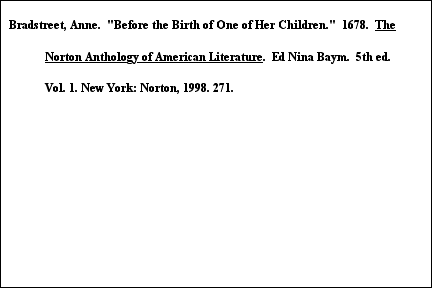
Taking Notes
Overview
A Note Card for a Direct Quotation
A Note Card for a Paraphrase
A Bibliography/Work Cited Note Card

Overview
As you undertake your research, you will want to
take some kind of notes on what you are reading. The purpose of
taking notes is to be able to remember who wrote what, where an idea
came from, or why you thought a point was particularly important. As
you work with a growing number of sources, taking notes will help you
sort and organize your work, particularly if you use them in tandem
with a good outline.
Many researchers still prefer using note cards;
others use a computer or scanner to eliminate the need for hand
writing notes. If you decide to use a computer for your note taking,
however, you should not just "dump" all your notes into one file.
This approach hinders rather than helps organization in the long run,
and the more notes you have, the more cumbersome it is. To use a
computer for note taking, create a card-sized template and then print
your notes out on cards or card-sized paper.
Taking notes by highlighting on Xerox copies of
books and articles is equally ineffective, as you cannot organize
notes that are made this way. The end goal is to be able to sort your
notes to match the major topic headings of your outline. While this
outline/note card system may at first seem like a chore, it will
ultimately make your writing task easier.
Some basics for taking notes are as follows
(adapted from Barnet & Bedau, Current Issues and Enduring
Questions):
- At the top of the note, give the source and
the page number (or paragraph number if from an electronic
source). If you've carefully prepared your bibliography cards, the
author's last name, or last name and a short title if you are
using two works by the same author, should suffice.
- Keep each note short, with only one idea or
quotation per card, and write only on one side of the
card.
- Summarize or paraphrase if you can, rather
than directly quoting.
- If you think the original writing is
especially effective or absolutely necessary to make the point,
then quote directly, making sure that when you quote, you copy the
original exactly.
- Following the quotation or paraphrase, on a
new line, add your own comments about what it
contains.
- See Using
Quotations for information on how to
change the internal quotations marks if you end up in your final
essay having a quotation within a quotation.


A Note Card for a Direct
Quotation
General Guidelines:
- Begin at the top by giving the author's last
name. If you have more than one author with the same last name,
use the last name and a first initial. If you have more than two
works by one author, use the author's last name and an abbreviated
title for the work.
- Add the page number. If you are using an
electronic source (a reprint of an article in an electronic data
base or a web site, for example), use the paragraph
number.
- Copy everything from the original exactly as
it appears. Do not change anything--not even internal quotation
marks.
- Begin and end the quotation with a double
quotation mark. These indicate that everything in between appears
exactly as it appeared in the original.
- If the material you are quoting appears across
two different pages, add a slash ( / ) and put the appropriate
page numbers on either side of it.
- Following the quotation, add your own comments
about the content.



A Note Card for a
Paraphrase
- Begin at the top by giving the author's last
name. If you have more than one author with the same last name,
use the last name and a first initial. If you have more than two
works by one author, use the author's last name and an abbreviated
title for the work.
- Add the page number. If you are using an
electronic source (a reprint of an article in an electronic data
base or a web site, for example), use the paragraph
number.
- Restate the material in your own
words.
- Do not begin or end with quotation marks;
omitting these quotation marks is an indication that you are
paraphrasing the material rather than quoting it directly.



A Bibliography/Works Cited Note
Card
- What information will appear on the
bibliography note card will vary, depending on the type of source.
Use Examples
of Entries for the Works Cited List, MLA
Style to determine what information to
include.
- Format your entry in correct MLA style to save
yourself work later when compiling your Works Cited
list.
- Be precise and copy information about the
source correctly.
- Titles of works independently published, such
as books, plays, and movies, may be underlined or italicized. The
titles of poems, essays, or articles should be placed in quotation
marks.




Last Updated 02/18/08
![]()
![]()




![]()
![]()